
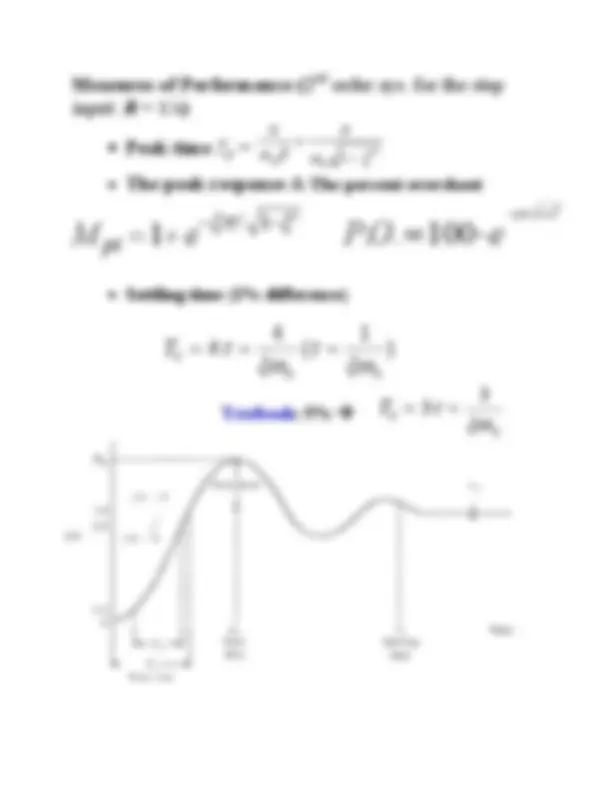
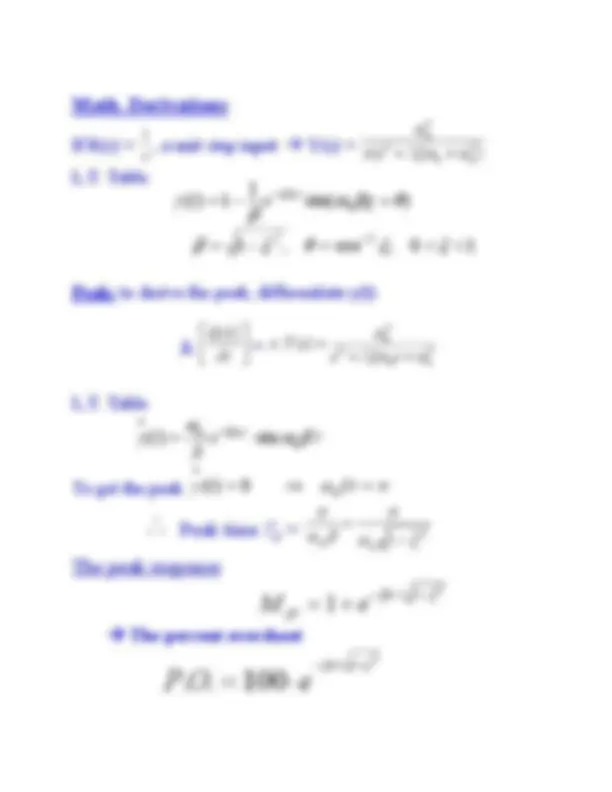
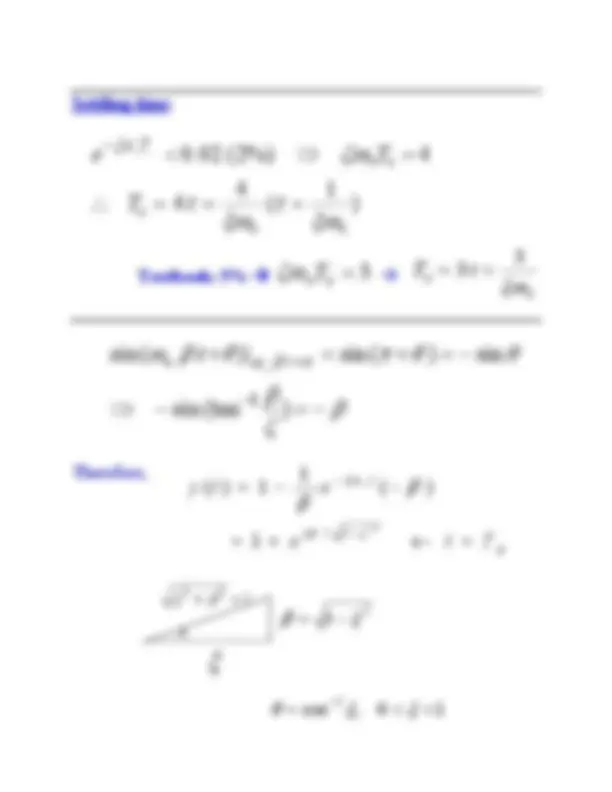
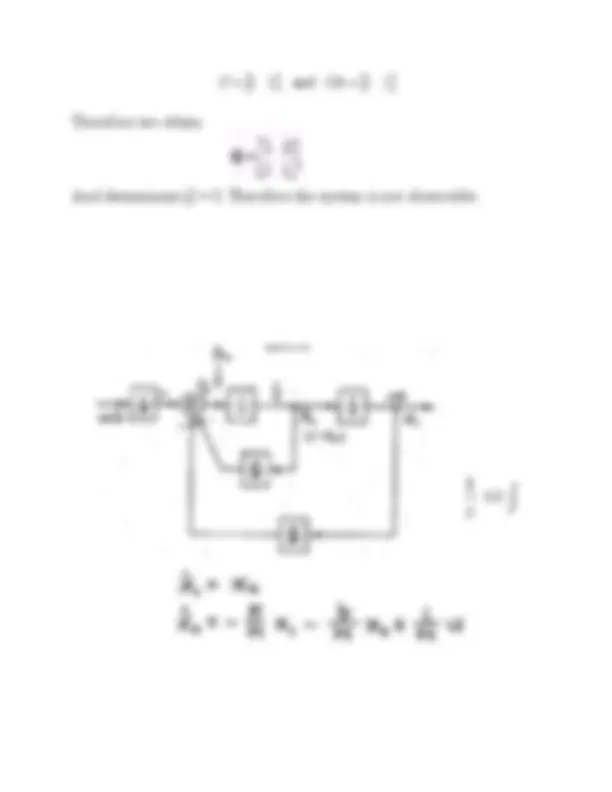
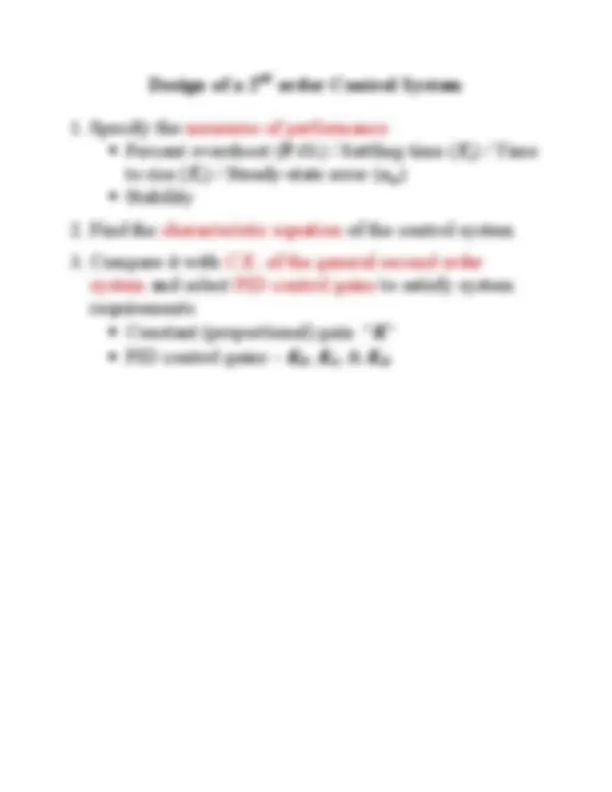
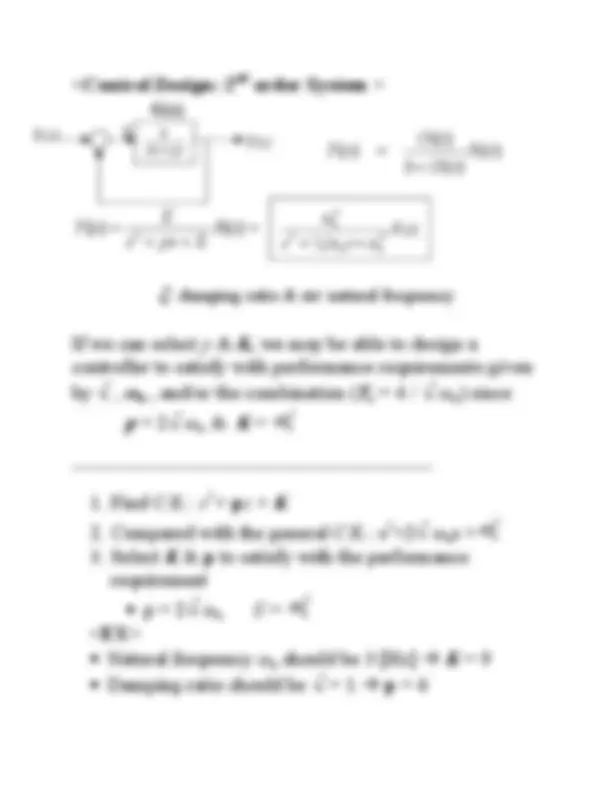
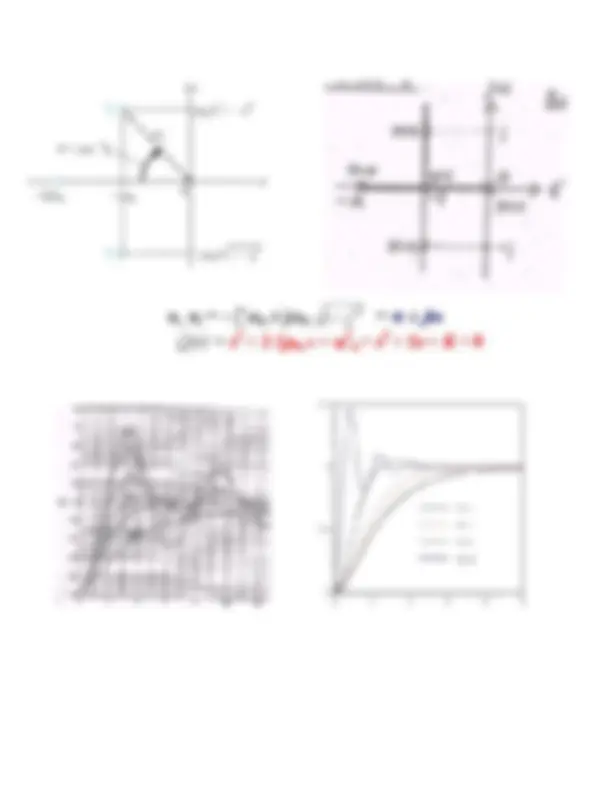
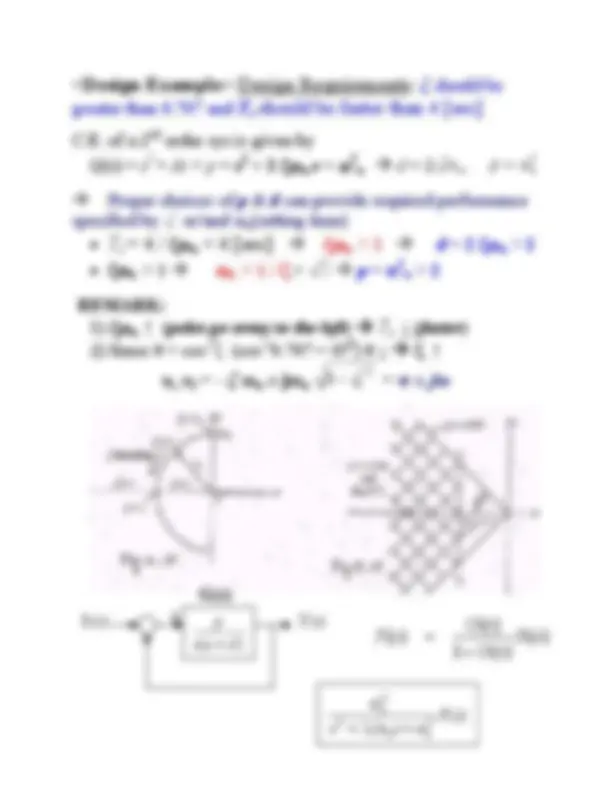
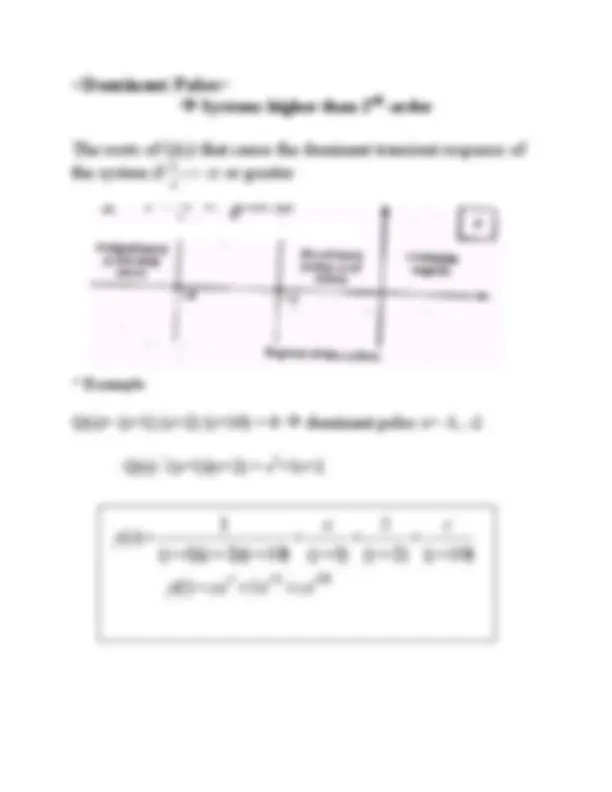


Study with the several resources on Docsity

Earn points by helping other students or get them with a premium plan


Prepare for your exams
Study with the several resources on Docsity

Earn points to download
Earn points by helping other students or get them with a premium plan
Community
Ask the community for help and clear up your study doubts
Discover the best universities in your country according to Docsity users
Free resources
Download our free guides on studying techniques, anxiety management strategies, and thesis advice from Docsity tutors
Material Type: Exam; Class: Linear Control Systems; Subject: Engineering: Electrical; University: University of Central Florida; Term: Unknown 2002;
Typology: Exams
1 / 17

This page cannot be seen from the preview
Don't miss anything!










The Performance of Feedback Control Systems
Objectives:
<Performance of a 2nd-order sys >
Y(s)
=
( )= 2 R ( s ) s ps K
Y s K
If we can select p & K, we may be able to provide desired
s1, s 2 = - ζ ωn ± jωn 1 −^ ζ^2 = σ ± j ω
G(s)
R(s) E
( ) 2 2 2
2 R s s (^) ns n
n ζω ω
ω
ζ : damping ratio & ω: natural frequency
s ( p )
k
( ) ( ) R s G s
G s Y s
s =
Math. Derivations
If R(s) = (^) s
1 , a unit step input Æ Y(s) = (^) ( 2 2 2 )
2
n n
n s s ξω ω
ω
L.T. Table
Peak: to derive the peak, differentiate y(t)
⎤ ⎢⎣
⎡ dt
dy ( t ) = (^22)
2 2
( ) n n
n s s
s Y s ξω ω
ω
⋅ =
L.T. Table
e t B
y t n^ nt ω n β
ω (^) ξω ( )= − ⋅sin
To get the peak = ⇒ ω^ β =^ π
y ( t ) (^0) n t
∴ (^) Peak time Tp = (^2) ω 1 ξ
π ω β
π −
= n n
The peak response
/ 1 2 1
−ξπ − ξ M (^) pt = + e Æ The percent overshoot / 1 2
.. 100
−ξπ − ξ PO = ⋅ e
sin( )
1 ( ) 1 ω β θ β
y t = − e −ζω^ g + n nt
β = 1 −ξ^2 , θ =cos−^1 ξ, 0 <ξ < 1
Settling time :
Textbook: 5% Æ ζω^ n Ts =^3 Æ n
Ts τ (^) ξω
β ζ
β
ω β θ ω β π π θ θ
⇒ − =−
−
=
sin(tan )
sin( )| sin( ) sin
1
n t n t
Therefore,
)
1 (
4 4
n n
s
n s
T
T
e n s T
ξω
τ ξω
τ
ζω ζω
∴ = = =
− < ⇒ =
θ
ξ^2 +β^2 = 1
ξ
p
w t
e t T
y t e n
−
−
/ 1 2 1
ξπ ζ
β = 1 − ξ^2
θ = cos −^1 ξ, 0 < ξ < 1
Observability
All the roots of the characteristic equation can be placed where desired in the s -plane if, and only if, a system is observable and controllable. Observability refers to the ability to estimate a state variable. Thus we say a system may be observable if the output has a component due to each state variable.
A system is observable if, and only if, there exist a finite time T such that the initial state x (0) can be determined from the observation history y ( t ) given the control u(t).
Consider the single-input, single-output system x = Ax + Bu and y = C x ,
⋅
where C is a row vector, and x is a column vector. This system is observable when the determinant of Q is nonzero, where
which is an [ n x n ] matrix.
Example: Observability of a two-state system Consider the system given by
In order to check system’s controllability and Observability, need to evaluate Pc and Q matrices. The matrices for Pc are
Therefore we have
And determinant Pc=0. Thus the system is not controllable. To determine Q we obtain
(3)
Therefore we obtain
And determinant Q = 0. Therefore the system is not observable.
s ⇔^ ∫
1
<Control Design: 2nd^ order System > G(s) Y(s)
=
( )= 2 R ( s ) s ps K
Y s K
If we can select p & K, we may be able to design a controller to satisfy with performance requirements given
2
2
2
R(s) E
( ) 2 2 2
2 R s s (^) ns n
n ζω ω
ω
ζ : damping ratio & ω: natural frequency
s ( p )
k
( ) ( ) R s G s
G s Y s
s =
EX (^) G(s)
(^2) + d s + p
ns +^
2
2
2
[Hz] From 2), p = 16 and
R(s) E
p Y(s)
( ) 2 2 2
2 R s s (^) ns n
n ζω ω
ω
s ( s + d ) 1 ( ) ( )
( ) ( ) R s G s
G s Y s
=
ss1,1, ss 22 = -= - ζζ ωωnn ±± jjωωnn 1 − ζ^2 = σ ± j ω
Q(s) = s^2 + 2 ζω n s + ω^2 n = s^2 + 2 s + K = 0
C.E. of a 2nd^ order sys is given by
Q(s) = s^2 + ds + p = s^2 + 2 ζω n s + ω^2 n Æ d = 2 ζω^ n ,^ p =^ ω n^2
Æ Proper choices of p & d can provide required performance specified by^ ζ^ or/and ωn (setting time)
REMARK:
G(s) R(s) E
( ) 2 2 2
2 R s s s
n ζω ω
ω
s ( s d )
p
( ) ( ) R s G s
G s Y s
=
Y(s)
PID controlPID control
s 2 +2^ ζ^ w s+n w n^2
s 2 +2^ ζ^ w s+n w n^2
E(s) (^) G (^) c(s) G (^) p (s) U(s) U(s) R(s)
Controller G (^) c(s)= kp + kI (^) s
1
Control input
U(s) = [k (^) p + kI (^) s
1
If G (s)=p (^) s s s 2 s
1 ( 2 )
1
dt
det u t kpe t kI e t dt kd
T(s)=
c p
p
p c p
Gc ⋅ G p s s k
k G G + +
= 1 + (^22)
Q(s)= s 2 +2s+k =
T(s)=
p
c p D
D p
k (^) D s + k p s^2 + ( 2 + k ) s + k Q(s)= s 2 +(2+ k )s + k =D p
k s k s
G (^) c s kp kI p I
( )= +^1 =
T(s) = (^) p I
p I s s k s k
k s k
2 ( 2 )
( ) 3 2
= (^) ( )( )
( ) 1 2 s a s^2 k s k
k (^) ps kI
k (^) D s^2 + kps + kI
T(s)= (^) D p I
D p I s k s k s k
k s k s k
3 2
2
( 2 )
( )(^212 )
2
s a s k s k
kDs kps kI
=
2
Select two poles (dominant poles) near to the origin for the comparison if there are more than two poles Æ compare the real part of poles
EX> if poles are at -1± j2, -
2